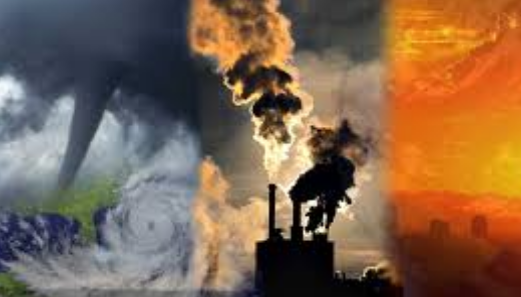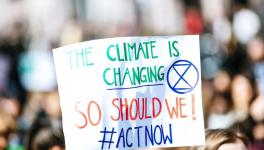India Moving Farther Away from Achieving 3rd Goal on Climate Change: IPCC Report

India is very vulnerable to climate change, especially because of the melting of the Himalayan glaciers and changes in the monsoon cycle. According to the latest report of the United Nations body to assess climate science, the Intergovernmental Panel for Climate Change (IPCC), climate change is likely to make rainfall erratic, lead to rising sea levels, and make extreme weather events like droughts, floods, and heat waves more frequent.
In 2019, India has already witnessed all of these extreme weather conditions, from heat waves to flash floods. While in parts of northern and southern India, states like Bihar, Karnataka and Maharashtra were struggling with drought-like conditions in the summer, the Northeast and western coastal areas have been battered with torrential rain in the ongoing monsoons. According to weather website El Dorado, out of the 15 places that received the most rainfall across the globe in the last 24 hours, eight are in India. Only two months back, the same weather listing source had counted four places in India among the world’s hottest 15 places.
Yet India, where one in every seventh person on the planet lives, has no national study on the impact of climate change, although about 600 million people are at risk from its effects, according to a study by the World Bank Group. The study says, “In India, inland states in the central, northern, and northwestern regions emerge as the most vulnerable to changes in average weather. Chhattisgarh and Madhya Pradesh—which are predicted to have a living standard decline of more than 9% — are the top two hotspot states, followed by Rajasthan, Uttar Pradesh, and Maharashtra. Chhattisgarh and Madhya Pradesh are also low-income states, home to large tribal populations. Changes in average weather could therefore have important implications for poverty reduction.”
Also read: Mumbai Deluge: Of Heavy Rains and Climate Change
According to a report by the Business Standard, to frame a viable policy on climate change, India first needs to have data that will help the policy-makers see the impact of climate change at regional levels. At the moment, no such data is available. According to the government, India is well on the trajectory to achieve two of its three commitments under the Paris Agreement ahead of the 2030 deadline. The government said this in a report submitted to the UN Framework Convention on Climate Change. The report enumerates India’s latest emission data and the kinds of threats the country is already facing from climate change.
Under the Paris Agreement, India has made three commitments. India’s greenhouse gas emission intensity of its GDP will be reduced by 33-35% below 2005 levels by 2030. Alongside, 40% of India’s power capacity would be based on non-fossil fuel sources. At the same time, India will create an additional ‘carbon sink’ of 2.5 to 3 billion tonnes of carbon dioxide equivalent through additional forest and tree cover by 2030.
However, according to the same report, the third goal, which is supposed to be achieved with the Green India Mission (GIM), does not look very achievable. On GIM, India is receding further from its target, rather than improving. Data from India’s Biennial Update Report shows that the carbon sequestration from forests has actually got worse between 2010-2014. Carbon removed from the atmosphere by forests is included in the emissions inventory as part of a broader category called, “Land use, land-use change, and forestry” or LULUCF. The report pegs the 2014 levels of emission removal by forestry at only 68,215 gigatonnes of carbon dioxide equivalent as compared to the 200,036 gigatonnes of carbon dioxide equivalent in 2010.
Also read:Climate Change: A Trillion Trees to Save Earth!
GIM’s launch was supposed to coincide with the starting of the 12th five-year plan in 2012. However, owing to the financial delays, the mission was finally launched in the fiscal year 2015-16. It is one of the eight missions launched under the National Action Plan on Climate Change (NAPCC), on India’s Nationally Determined Contribution (NDC) submitted to the United Nations Framework Convention on Climate Change.
According to a Parliamentary committee report presented to the Lok Sabha in December 2018, the mission is “grossly underfunded”. The report said that the budget allocation and expenditure for NAPCC have been on a constant decline since FY 2015-2016. It said, “Budget allocation of ₹47.80 crore for FY 2017-18 is grossly insufficient. The committed liability of FY 2015-16 and 2016-17 is ₹89.53 crore, which is more than the budget allocation of FY 2017-18."
The Parliamentary committee had also raised concerns about the targets set by GIM. According to the NDC, India has a target to sequester 2.523 billion tonnes of carbon by 2020-2030. When questioned about this by the panel, the Secretary of Ministry of Environment, Forest and Climate Change (MoEFCC) said, “Our current forest cover is 75 million hectares, and to meet our target of carbon sequestration, 30 million hectares of additional land would be required for forests.” The mission document does not mention how this would be arranged.
Also read: Human Activities on Land Account for 23% of Greenhouse Gas Emission: IPCC
This makes one wonder whether the progress made by the country towards achieving the other two goals will be negated by the government’s lack of planning to achieve the third goal, and it’s inability to even maintain the current level of carbon sequestration by the available forest cover. When questioned in the Lok Sabha about whether the government has any scheme for the conservation of forests and rehabilitation of the people displaced from forest areas, the Minister of State in the MoEFCC Babul Supriyo said, “The ministry implements a number of schemes for the conservation of forests. However, the ministry does not have any specific scheme that addresses conservation of forests and rehabilitation of the people displaced from forest areas. The information of number of persons displaced from forest areas is not maintained at ministry level.”
Get the latest reports & analysis with people's perspective on Protests, movements & deep analytical videos, discussions of the current affairs in your Telegram app. Subscribe to NewsClick's Telegram channel & get Real-Time updates on stories, as they get published on our website.
























